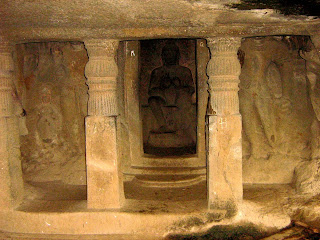The word Pandavleni is actually a misnomer because these caves arent even remotely connected to the Pandavas ( heroes of the epic Mahabharata ). These caves are infact Buddhist monasteries that were excavated first in the last century BC. These excavations were carried forth right upto 12th cen AD.
The caves are located on a hill (Trirashmi, as per a inscription) across the Mumbai Nasik highway (near Ambad MIDC) which was once a part of an ancient route.
One needs to climb a series of stone steps to access these caves and it generally takes half an hour for an average person to reach the top.
These caves were chiselled out from the igneous rock that forms the major composition of these mountains. Its earliest excavation initiated by the followers of the Hinayana branch of Buddhism. But with time they came to be influenced by its Mahayana branch as well.
The caves are in all 24 in number and linearly aligned in single or double storeys.
This cave monastery came to be patronized by several kings belonging to the Satavahana dynasty (Yagna Satkarni, Vashishtaputra Pulumavi,Gautamiputra Satkarni,Krishna-brother of Simhuk,Bhattapalika, etc) as also the Saka Khshatrapas (Dakshamitra, Ushavadant and Nahapana) who had a presence in these regions.
With the gradual decline of Buddhism, the Jain monks began occupying these caves and contributed to their structure . Thereafter several Jain sculptures (of Vrishabhdev, Veer Manibhadra , Ambikadevi, Mahavira etc) were etched out by artisans. Certain portions also came to be dedicated to the Hindu gods like Hanuman and Shiva.
Note: Mahavira is usually accompanied by a lion (and a chakra) and his yaksha attendents Matanga and Siddhaiyika. Nudity is a hallmark of Jaina images.
Cave no 11: has images of Mahavira, his yakshas Sidhayika/ Ambika riding a lion, Matanga riding a elephant.
Cave no 11: has images of Mahavira, his yakshas Sidhayika/ Ambika riding a lion, Matanga riding a elephant.
The main cave in Pandavleni is the chaityagriha or the prayer hall. Its imposing ornate façade immediately grabs ones attention .
It features a doorway leading one inside the hall. It is adorned by a intricately carved chaitya-gavaksha along with motifs embellishing its face.
One comes across a large stupa with a barrel vault ceiling and supported by an array of pillars. Some of the pillars have inscriptions in brahmi carved on their face.
pic:Gautami-devi leni with yakshas carved on the walls
The rest of the caves are mainly viharas or dwellings for the monks.
They mainly consist of rooms with an array of pillars supporting the verandah walls.There are sculptures of men mounted on elephants and lions carved on the capitals of these pillars, while yaksha carvings deck up the the face of the verandah walls.
The inner walls of the viharas have large carvings of Buddha (or Jaina images?- Note: Buddha has a ushnisha or a hair knot crowning his head) in seated, standing and sleeping positions, flanked by the Bodhisatvas and female attendents.
pic:Gaja,Vrishabh,Sinha shilpa on the pillar capitals (as also Griffin-greek mythical beast with a eagle head n animal body, Sphinx- greek/egyptian indicating influence of greek architecture )
There are carvings of animals like elephants, cattle, lions, mythical creatures like half bird half beasts, half human half animal etc displayed on the walls. While some caves feature sculptures of Jain tirthankaras, kings and munis.
The caves are said to have around 27 inscriptions (in cave nos 3,11-15,19,20) in the ancient bramhi script mentioning details regarding the donors, the exploits of the prevalent kings and a general record on Buddhism in those ages.e.g Gautami Balashris inscription praising the virtues of her son Gautamiputra Satkarni,Agnimatras (Amatya Chalisanaka's daughter,Bhadkarikas wife and mother of Kapanika) inscription mentioning the name of the hill Trirashmi on which the caves are situated.
Pandavleni caves with its rich sculpture are a treat for all connoisseurs of art, history and culture and can be compared to the best amongst the cave architecture as seen at Karla, Bhaja, Bedse or Kanheri.
Additional photographs:
pic:Yadna vihar Buddha
Text and Photographs by Abhijit Rajadhyaksha




































